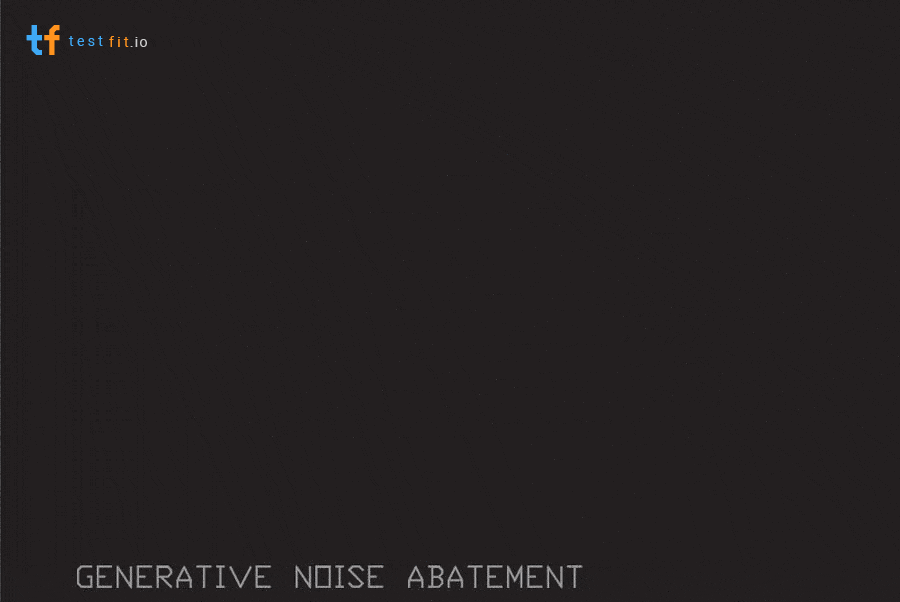
This is our proposal for the NMHC Innovation Challenge! Since we are deeply committed to multi-family innovation, we knew we had to submit. Here is the problem they set up:
"Noise from neighbors transmitted through apartment walls represents one of the most common renter complaints and frankly is a barrier to apartment living for some people. Cost-effective solutions for noise reduction in apartments would significantly reduce property management challenges and would improve the desirability of apartments as a housing choice."
Too Long; Didn't Read
Problem: Apartments are loud.Solution: Configure units with a generative noise abatement algorithm. Sandwich noisy living spaces between bedrooms, closets, and bathrooms. Visual representation below.Why this Solution? It costs effectively $0.

How did we get to this solution? Read below.
Defining the Problem
Apartment communities are inherently noisy because there are more people in less space. Our objective is to mitigate noise. For our purposes in this elaborate thought experiment, we will consider five levels of neighbor:
- A perfect neighbor will always observe "silence" (the perfect neighbor does not exist)
- A good neighbor assumes paper-thin walls still transmit everything except their "inside voices"
- "Considerate" neighbors keep everything at a reasonable volume
- "Inconsiderate" neighbors love to listen to heavy metal on full blast at 3 in the morning
- "rage-inducing" neighbors throw parties that quite possibly turn into a mosh-pit, irritating everyone in all surrounding units
Let's say we have a hypothetical building comprised of only four units. The occupant of the 1 Bedroom could have the following impact on those around him:

The solution to problem is simple: configure unit adjacencies to mitigate sound transmission.
Defining our Assumptions
Room noise depends on type of room and time of day:

- Kitchens are used around mealtimes...assume the blender is always being used to blend ice
- The Living Room is consistently used in the evenings...assume the television is on LOUD
- Bedrooms are reasonably quiet around the clock
- Bathrooms are loud during morning and evening transition periods...assume shaky pipes
- Closets are reasonably quiet around the clock
- The living space (Kitchen+Living Room) should be mitigated
Use walls to our advantage:

- In general, more walls increase transmission loss; improving sound proofing
- Rooms adjacent to loud rooms are affected by that noise
- Rooms adjacent to the rooms adjacent to the loud rooms are less affected by that noise (and so on)
Apartments Follow Three Basic Designs

- One living space; bath/closet to the side
- One living space; one bedroom/bath/closet to the side
- One living space; between bedroom/bath/closet suites
- Closets can always be placed on the edge of a unit
Living Space Simulations

Studio living spaces negatively impact everything from the sound perspective

1 Bedroom spaces are insulated to one side, but negatively impact the adjacent unit

2 Bedroom living spaces are perfectly insulated within their own unit.

3 Bedroom living spaces are also perfectly insulated within their own unit.Conclusions from the simulations
- Studios offer no sound mitigation
- 1 bedrooms offer sound mitigation to one side
- 2 bedrooms offer sound mitigation on both sides
- 3 bedrooms offer sound mitigation on both sides, and double on one side
Rules for the Unit Placement Algorithm
First Priority: place studios and 1 bedrooms against staircases and elevator cores
Second Priority: Place as many bedroom suites between living spaces as possible
Third Priority: Place at least one bedroom suite between living spaces as possible
Fourth Priority: Flip units to increase transmission loss
Fifth Priority: Highlight areas that could use higher transmission loss assemblies
Generative Noise Abatement Algorithm

Thank you for reading this far. We hope this kind of thinking (which has close to no hard cost impact) can be used to solve other problems!Further exploration? How we can achieve noise mitigation between building levels (rather than only in plan).
Curious about TestFit?






